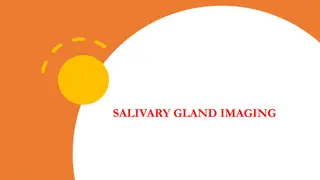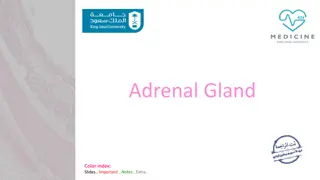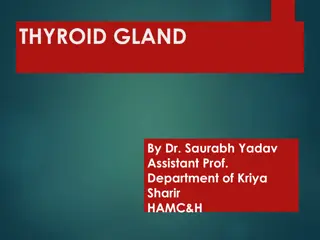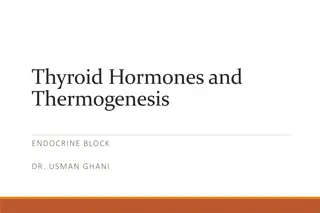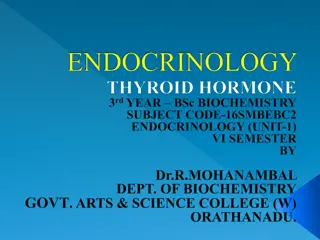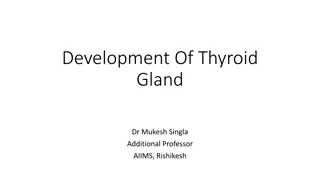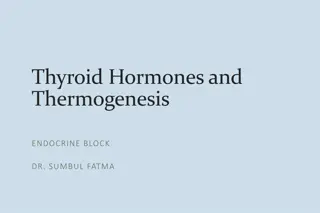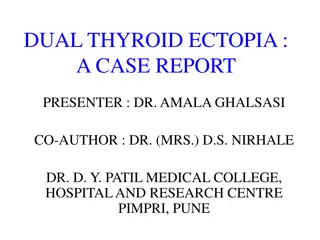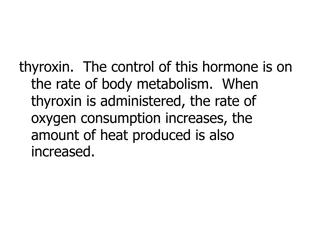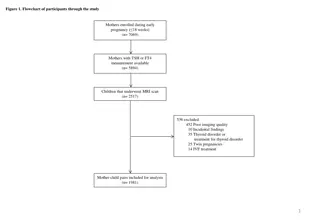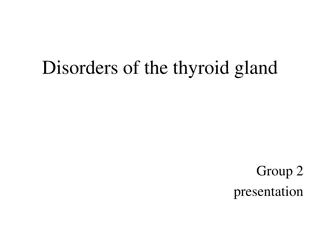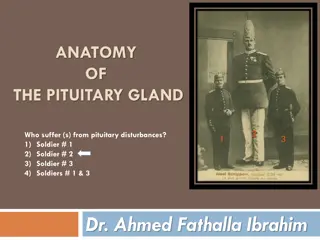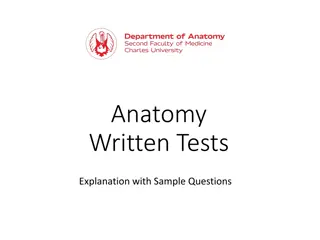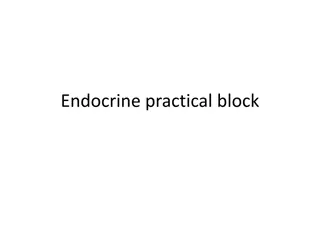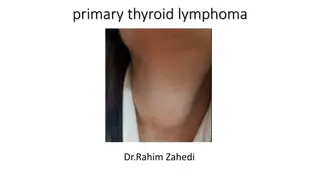Thyroid Gland: Anatomy and Function
The thyroid gland is a butterfly-shaped organ located in the neck, vital for hormone production. Understand its structure, blood supply, nerves, and hormonal regulation. Learn about thyroid disorders, diagnostic tests, and treatment options like fine needle aspiration. Explore the roles of thyroglobulin, iodine, thyroid-stimulating hormone (TSH), and thyroid hormones in body metabolism. Examine the significance of the hypothalamus in hormone regulation and the impact of abnormal thyroid activity on health.
Uploaded on Mar 04, 2025 | 2 Views
Download Presentation

Please find below an Image/Link to download the presentation.
The content on the website is provided AS IS for your information and personal use only. It may not be sold, licensed, or shared on other websites without obtaining consent from the author.If you encounter any issues during the download, it is possible that the publisher has removed the file from their server.
You are allowed to download the files provided on this website for personal or commercial use, subject to the condition that they are used lawfully. All files are the property of their respective owners.
The content on the website is provided AS IS for your information and personal use only. It may not be sold, licensed, or shared on other websites without obtaining consent from the author.
E N D
Presentation Transcript
Butterfly-shaped organ composed of two cone-like lobes or wings: right lobe and left lobe, connected with the isthmus. Situated on the anterior side of the neck, lying against and around the larynx and trachea, reaching posteriorly the esophagus and carotid sheath. It starts cranially at the oblique line on the thyroid cartilage (just below the laryngeal prominence or Adam's apple) and extends inferiorly to the fifth or sixth tracheal ring.
Arterial supply:Superior thyroid artery; inferior thyroid artery; Thyroid imaartery. Venous drainage :Superior thyroid vein; Inferior thyroid vein; Middle thyroid vein. Lymphatic drainage: - lateral deep cervical lymph nodes (Jugular chain) - pre-and paratracheallymph nodes(central compartment).
Laryngeal nerves -Recurrent laryngeal nerve: variable positions.70% run in the tracheoesophageal groove. it is important to always identify the nerve. -Superior laryngeal nerve runs near the superior thyroid artery
The thyroid gland is composed of many spherical hollow sacs called thyroid follicles. The principal cells, which surround the follicle, are simple cuboidal epithelium. These follicles are filled with a colloid, which usually stains pink. The principal cells use the thyroglobulin and iodide stored in the colloid to produce the thyroid hormones. Between these follicles are the parafollicular cells(C) which produce calcitonin
The hypothalamus secretes thyrotrophin releasing hormone (TRH),which stimulates the production of thyroid stimulating hormone (TSH) from the anterior pituitary . TSH I increases production & release of thyroxineT4 & TriiodothyronineT3 from the thyroid.
Abnormal activity: 1. Hyperthyroidism 2. Hypothyroidism Abnormal cells: 1. Benign 2. malignant
a-Abnormal activity: TFT (TSH, T3, T4). B-measuring specific antibodies. b-Abnormal cells: FNA, thyroid scan and/ or thyroid US.
Fine needle aspiration: FNA is extremely accurate & is the single most important study in evaluating thyroid mass except in follicular injury. Results of FNA will be one of four: -Benign(noncancerous). -Malignant(cancerous). -Suspicious. -Nondiagnosticor inadequate The major difficulty in FNA is to distinguish between follicular adenoma vs. carcinoma.
Because thyroid cancer cells do not take up radioactive iodine as easily as normal thyroid cells do, this test is used to determine the likelihood that a thyroid nodule contains a cancer. Diffuse uptake in graves disese. The scan usually gives the following results: -The nodule is cold. 15% cancer -The nodule is functioning. likelihood of cancer is very low -The nodule is hot. The likelihood of cancer is extremely rare the
28fig15 This very sensitive test can easily determine if a nodule is solid or cystic, and it can determine the precise size of the nodule. can be used to assist the placement of the needle within the nodule during a fine needle biopsy, especially if the nodule is hard to feel. can identify nodules that are very small and cannot be felt during a physical examination. The clinical importance of these very small nodules is uncertain; however, the ultrasound provides a mean by which an accurate fine needle biopsy can be performedif a biopsy is needed. Also used to see lymphatic mapping
1ry hypothyroidism: 95% 1-hashimoto s disease 2-iatrogenic ( from prior rxof hyper) 2ndry hypothyroidism : due to pituitary disease ( low TSH) 3ry hypothyroidism : Due to hypothalamic disease ( low TRH) Both are less than 5% associated with low TSH &T4
Metabolic: cold intolerance, appetite, wt gain, constipation, Abnormal menstruation (oligo or hyper). Cardiovascular: Bradycardia Neuropsychiatric: delayed reflexes, Depression . Cutaneous: coarse hair; nails and skin, puffy face, enlargement of the tongue and hoarseness.
1-TFT: ( high TSH) most sensitive indicator of 1ry disease but low is 2ry disease. measuring just TSH fails to diagnose secondary and tertiary hypothyroidism (Low free T4) in clinically overt disease but may be normal in subclinical cases. 2- Antithyroid antibodies: increased in hashimoto s thyroditis.
3- other laboratory values that may be abnormal: Serum cholesterol elevaedLDL & decreased HDL Anemia may be present. 4-prolactin its used to test the pituitary function
thyroxine(levothyroxine) (L-T4): Once daily morning dose . Continues indefinitely. Monitor TSH level periodically.
Diffuse toxic goiter (graves disease): 80% most common. Autoimmune disorder Diffuse uptake on thyroid scan. Multinodular toxic goiter (plummer s disease) 15% Hyperfunctioning areas more common in elderly. Patch uptake on thyroid scan or normal. Toxic adenoma Hashimoto s thyroiditis Rare causes: postpartum & iodine induced.
Metabolic: Heat intolerance, increased appetite with weight loss, diarrhea, menorrhagia Cardiovascular: Palpitations, tachycardia even while asleep, atrial fibrillation Neuropsychiatric: Hyperkinesis, insomnia, emotional instability, tremor, proximal myopathy Ocular: Exophthalmos including proptosis, lid retration and eventually ophthalmoplegia Cutaneous: Pretibial myxoedema
1-TFT: ( high TSH) (high T4) (T3) usually unnecessary but helpful if TSH&T4 is low . Excess T3 can cause hyperthyroidism. 2- radioactive T3 uptake: Increase T3 uptake. 3- measuring specific antibodies: such as anti-TSH- receptor antibodies in Graves' disease
1-Thyrostatics (antithyroid drugs) inhibit the production of thyroid hormones, such as carbimazole (used in UK) and methimazole (used in US), and propylthyouracil. 2- Beta-blockers used to treat high blood pressure, reducing rapid pulse and decreasing tremor and anxiety. 3- sodium ipodate : lowers T3,4 rapidly in pts with severe disease who is not responding to conventional therapy.
3- Radioiodine 131 radioactive iodine-131 is given orally (pill or liquid). it tends to have success rate (75% -100%) which is much higher than medications. # in pregnancy and breastfeeding. Complication is hypothyroidism. 4-Surgery (total or subtotal thyroidectomy) is not extensively used because most common forms of hyperthyroidism are quite effectively treated by the radioactive iodine method.
Thyroid storm: presents with extreme symptoms of hyperthyroidism. presented with : increase in body temperature to over 40C, tachycardia, arrhythmia, vomiting, diarrhea, dehydration, coma, and death Treatment: 1. Resucitation with an intravenous beta blockers such as propranolol 2. thionamide such as methimazole, 3. intravenous steroids such as hydrocortisone
Classification of goiter: 1- Diffuse goiter: Spread to all thyroid. Can be simple or multinodular 2-Toxic goiter: Goiter + hyperthyroidism (high f T4) Cause: Grave s (common),inflammation, or multinodular goiter 3- Non toxic goiter: Goiter + eu-or hypo-thyroidism Cause: lithium, other autoimmune disease
euthyroid multinodular goiters:No surgery or medical therapy. Only Serial thyroid US: to follow the size of nodules. Larger multinodular goiters: Either CT or MRI scan to exclude tracheal compression and to assess thyroid size. toxic multinodular goiters The definitive management is biopsy of suspicious nodules or surgical excision, followed by radio- iodine therapy.
Indication of surgery in simple goiter: 1-There is clinical or radiological evidence of compression. 2-Substernal goitres are best removed surgically, as biopsy is difficult and clinical observation without frequent CT or MRI scans is impossible. 3-The goitr continues to grow. 4-Cosmetic reasons if large or unsightly.
Total thyroidectomy (the mostcommon procedure).This reduces the risk of recurrence but makes hypothyroidism almost inevitable. !! Near total thyroidectomy: remove all thyroid tissue leaving small amount around parathyroid gland and recurrent laryngeal nerve !! Not done in Grave s disease.Why?
1-Patient preference, e.g. fear of radio-iodine 2-Children (radio-iodine or prolonged drug treatment remain an option) 3-Pregnancy (medical treatment is usually preferred) 4-Large goitr (particularly multinodular goiter, with local compressive symptoms) 5-Severe reaction to anti-thyroid drugs (but radio-iodine remains an option) 6-Severe ophthalmopathy (medical therapy remains an option) 7-Suspicious nodule plus hyperthyroidism (perform fine needle aspiration cytology first) 8-Complex situations, e.g. poor compliance with anti-thyroid drugs and radio-iodine is refused
The term thyroid nodule refers to any abnormal growth of thyroid cells into a lump within the thyroid. Although the vast majority of thyroid nodules are benign (noncancerous), a small proportion of thyroid nodules can be malignant.
1. Colloid nodules and follicular neoplasms it is the most common types of noncancerous thyroid nodules 2. Autonomous nodule a nodule produces thyroid hormone without regard to the body s need. 3. Thyroid cyst If the nodule is filled with fluid or blood 4. Hashimoto s thyroiditisif the cause is inflammation known, the patient with hypothyroidism
Thyroid nodule can be associated with: Euthyroid pts: Can be cancer Hyperthyroid pts: Almost never cancer. adenoma") (" hot
Indications for surgery in thyroid nodules: 1-Malignant or suspicious fine needle aspiration cytology. 2-Larger nodule with repeated non-diagnostic fine needle aspiration. 3-Continued growth of nodule after fluid removal and thyroid hormone therapy. 4-Symptomatic nodules (pain or pressure). 5-Continued patient anxiety.
6-Some clinicians recommend surgical removal of all nodules of diameter over 4 cm. 7-Hot nodules: a hyperthyroid hot nodule should be treated with radio-iodine or surgery. Surgical thyroid lobectomy is effective and safe therapy for hot nodules, and the risk of hypothyroidism after a hemithyroidectomy is low.
1. Papillary carcinoma: commonest 70-80%of thyroid cancer (in KSA > 90%) Slow growing Female : male 3:1 Spread by lymphatics (50% have +ve node at diagnosis) 2. Follicular carcinoma: the second most common 10% of thyroid cancer (in KSA 5%) More aggressive, Female : male 3:1 metastasis to lung and bone(Hematogenous)
3. Mixed papillary and follicular carcinoma 4. Medullary thyroid carcinoma (MTC): A distinct thyroid carcinoma that originates in the parafollicular C cells of the thyroid gland. These C cells produce calcitonin. MTC is the only thyroid cancer that reliably expresses a tumor marker that is measurable in the serum (calcitonin) 7% of thyroid cancer (in KSA ~ 3%) Aggressive 90% sporadic, 10 % associated with MEN-2 95% produce calcitonin (as a tumor marker) 85% produce carcinoembryonic antigen
5. Malignant lymphoma: 5% of thyroid cancer (in KSA ~ 1%) Usually In female, with history of Hashimoto s thyroiditis Rapid enlargement with compressive symptoms 6. Anaplastic carcinoma:atient usually dies within 6 months after the diagnosis. The surgical intervention is only palliative by cutting the isthmus. Commonly presents as a rapidly-growing mass,often with symptoms of compression of neck structures and early development of distant metastases
7. Hurthle cell tumor intermediate aggressiveness spread by lymphatic male: female 2:1
Secondary cancer of the thyroid gland is widely acknowledged as infrequent but is a persistent problem requiring ongoing awareness, particularly with respect to clinical recognition and treatment. metastatic thyroid cancer can be from oral cavity , breast, lung, colon, prostate and kidney malignancies. Or from adjacent structures like larynx and esophagus. Theses can be detected by fine-needle aspiration biopsy in the face of clinical findings.
Where indicated, palliative thyroidectomy can be effective, because other methods of treatment appear ineffective.
Well-differentiated thyroid cancer (papillary & follicular) -Bilateral total or near-total thyroidectomy with appropriate nodal dissection is the procedure of choice. Medullary thyroid carcinoma -Treatment is surgical, consisting of bilateral, near-total thyroidectomy, central lymph node compartment dissection, and exploration of the jugular lymph node chain. -Pre-operative screening for phaeochromocytomais mandatory prior to surgery for medullary thyroid carcinoma, because hypertensive crisis may develop if surgery is performed on a patient with an unsuspected phaeochromocytoma (associated with medullary thyroid carcinoma in MEN Type II).
Anaplastic thyroid carcinoma -When complete resection is possible, surgical resection followed by external radiation may be beneficial. -More often, resection is not possible but external radiation may control aggressive local neck disease. lymphoma -Treated by radiation &/or chemotherapy,no surgery except if compression symptoms.
Preparation for surgery: -Thyrotoxic patients should have treatment with propranolol and/or carbimazole to ensure they are euthyroid at operation. -Potassium iodide has also been used. -In view of the possible operative damage to the recurrent laryngeal nerve, the vocal cords should also be checked prior to thyroid surgery
Complications Of Thyroid surgery
1-Bleeding:may cause tracheal compression. 2-Recurrent laryngeal nerve injury: Innervates all of the intrinsic muscles of the larynx, except the cricothyroid muscle. Patients with unilateral vocal fold paralysis present with postoperative hoarseness. Presentation is often subacute and voice changes may not present for days or weeks. Unilateral paralysis may resolve spontaneously. Bilateral vocal fold paralysis may occur following a total thyroidectomy, and usually presents immediately after operation Both vocal folds remain in the paramedian position, causing partial airway obstruction.
3-Thyrotoxic storm: is an unusual complication of surgery but is potentially lethal, usually happen in post-op thyrotoxicosis. 4-Hypoparathyroidism: the resulting hypocalcaemia may be permanent but is usually transient. The cause of transient hypocalcaemia postoperatively is not clearly understood. Postthyroidectomy ischemic parathyroid 5-Hypothyroidism.


